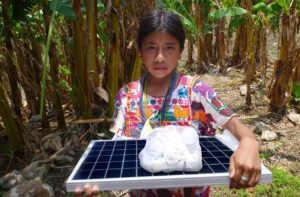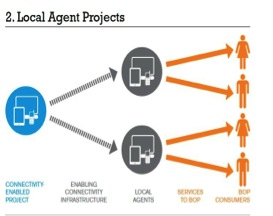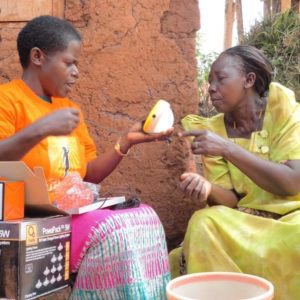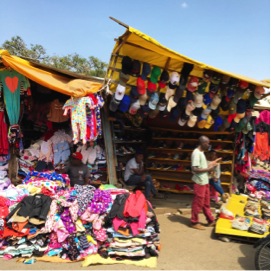
Search
There’s a lot riding on the increased production and broader distribution of energy in the developing world – more than is probably fair to expect. Hopes are high it can help eliminate extreme poverty and – especially in the case of renewable sources like off-grid solar – help crack the code on base of pyramid sales (BOP), while empowering impoverished women.
The challenges are daunting with the World Bank estimating that 1.06 billion people are without electricity (“only a slight improvement since 2012”). Organizations have also found implementing the “low price, low margin, high volume” base of pyramid sales model difficult. But there are hopeful signs, as $200 million in venture capital flows into the cleantech industry and the percentage of electricity produced from renewable sources has increased steadily since 2008.
One the ground, however, social enterprises like Solar Sister, Ilumexico and Proyecto Mirador, with whom we work, still face many day-to-day challenges selling solar products and clean cookstoves to the poor in parts of Africa, Mexico and Ecuador. Each organization is using mobile app software and cloud computing tools to manage data collection, base of pyramid sales and field operations. They are also drawing on lessons learned from BOP selling experience to meld energy demand with economic opportunity.

Solar Panel. Source: Ilumexico
If the people buying or selling renewable energy products are women, research shows the economic benefits can be multiplied.
“Putting income and energy in women’s hands can have powerful economic and social impacts on women’s lives, as well as the lives of their families and communities,” according to a 2015 study of Solar Sister’s work by the International Center for Research on Women (ICRW).
“Evidence shows that the income of self-employed, rural women who have access to energy is over twice that of their counterparts without access to energy. For rural women, access to energy is correlated with 59% higher wages.” (Read more)
In the end, it’s all about making a profit from BOP consumers, which helps sustain and scale businesses trying to reach that market, according to Erik Simanis, managing director of Market Creation Strategies at Cornell University’s Center for Sustainable Enterprise and Duncan Duke, an assistant professor of management at Ithaca College’s School of Business.
“Profitably selling to the bottom of the pyramid is difficult, but it can be done. It requires companies to focus on business fundamentals and start their ventures with a rigorous understanding of two key challenges in low-income markets: changing consumers’ behavior and changing the way products are made and delivered. Companies that underestimate these hurdles miscalculate the resources, innovation capabilities, and time involved, and project teams end up poorly equipped to accomplish the task.” (Read more)
Solar Sister delivers solar products and clean cookstoves in developing countries through a “local agent” model, which has helped it build a network of 2,500 largely female entrepreneurs who buy the products from Solar Sister and resell them at a profit to BOP consumers in locations like rural outdoor markets or at local savings groups across Uganda, Nigeria and Tanzania.
Solar Sister estimates the work has benefited 800,000 people with renewable energy and clean cooking tools that can improve a household’s economic standing and health while providing a source of income, business experience and leaderships skills that come with training from Solar Sister and an entrepreneur’s experience in the field.

Source: Hystra Hybrid Strategies Consulting
Solar Sister has encountered just about every obstacle you can face in base of pyramid sales. One of the major hurdles, according to Solar Sister’s Chief Operating Officer David O’Connor, is the basic problem of keeping track of and keeping in touch with field teams dispersed over large areas of Uganda, Nigeria and Tanzania.
Using TaroWorks’ offline mobile CRM app for tracking base of pyramid sales transactions in the field, and analyzing results in Salesforce.com, has helped Solar Sister improve the productivity of the business development associates who sign up Solar Sister entrepreneurs, sell them products for resale and train the Solar Sister entrepreneurs to manage their own small business.

Source: Solar Sister
Prior to using a mobile app, Solar Sister relied only on Salesforce to track solar lighting sales and entrepreneur relationships. The product purchases and entrepreneur interactions were recorded by Solar Sister’s field team on paper and then logged into the Salesforce database by hand. Tracking the movement of solar lamp inventory was also a painstaking manual process.
Solar Sister has completely replaced their paper processes and now generates sales invoices digitally, all of which are logged in the cloud-based database. Paper sales receipts can also be printed out from mobile devices for customers and the work of the field business development associates is managed remotely by creating trackable performance goals and task lists – as well as scheduling sales calls.
Among the lessons O’Connor believes Solar Sister has learned selling cleantech products to the BOP are the importance of keeping the sales model and related processes simple and applying the model and practices consistently across every interaction with both sellers and potential consumers. What has using mobile and cloud-based technology done to further Solar Sisters base of pyramid sales efforts?:
“It helps us identify what strategies are and aren’t working in real-time and iterate upon our processes on a weekly basis,” writes O’Connor. “A specific metric that is now one of our main key performance indicators as an organization is to track the level of engagement (based on the frequency of their sales) of our entrepreneurs. We created this metric as a way to encourage our team to focus on the retention of our entrepreneurs because the data was telling us that we had too many entrepreneurs who would purchase a couple times and then leave. As a result of setting up this metric that would only be possible with the use of our (mobile and cloud-based) systems we have seen increased retention of our entrepreneurs.”
On a larger scale, major consumer products companies like Unilever have developed several strategies (some obvious, some less so) to sell successfully deliver on base of pyramid sales as outlined in the Harvard Business Review:
● “Tap women to power sales
● Find grassroots distribution strategies
● Offer services rural consumers need
● Create new channels for advertising
● Design products (and set prices) for rural consumers
● Help managers adopt a rural mindset” (Read more)

Nairobi’s Toi Market. Source: Howard Sherman
Smaller entrepreneurs and informal workers in developing countries are using mobile technology to help them sell to local consumers and run their businesses more effectively. One South African startup is launching a mobile application to help informal traders compare bulk prices and order stock from their phone for their “spaza shops.”
A year-long study, begun in 2015 by Women in Informal Employment: Globalizing and Organizing (WIEGO) and Practical Action, assessed the effect of technology on those serving BOP consumers like street vendors and market traders, non-motorized transport operators, construction workers, garment workers, incense stick rollers and market porters.
“… many informal workers reported that they used mobile phones, and other basic ICTs in their work, even if they don’t own them. First and foremost, informal workers use these mobile phones to get market information: on whether suppliers have stock available, whether contractors have work available, and what the prevailing price or wage rate is.”
“The available evidence suggests that individual informal workers adapt or invest in technologies to increase productivity and incomes, to address occupational health and safety concerns, and to compensate for wider structural constraints. But the adaptations or investments are quite modest…” (Read more)
POST TOPICS
Sign up to receive emails with TaroWorks news, industry trends and best practices.
TaroWorks, a Grameen Foundation company.
Site by V+V